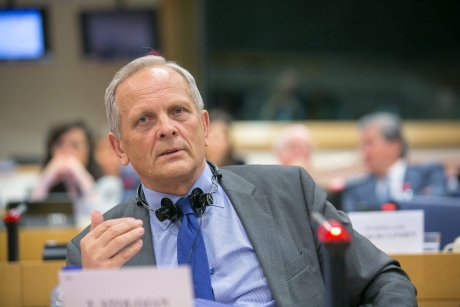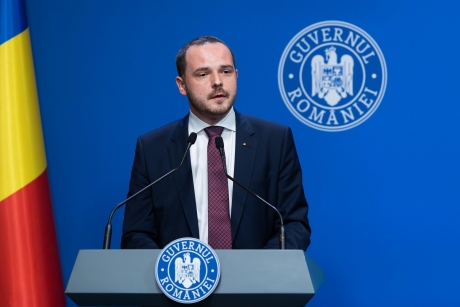In its meeting of 5 October 2023, the Board of the National Bank of Romania decided:
- to keep the monetary policy rate at 7.00 percent per annum;
- to leave unchanged the lending (Lombard) facility rate at 8.00 percent per annum and the deposit facility rate at 6.00 percent per annum;
- to keep the existing levels of minimum reserve requirement ratios on both leu- and foreign currency-denominated liabilities of credit institutions.
The annual inflation rate continued to decline in the first two months of 2023 Q3 overall, in line with forecasts, going down from 10.25 percent in June to 9.43 percent in August, amid the deceleration in the growth rate of food prices and the further drop in energy price dynamics, only partly counterbalanced, in terms of impact, by the hike in fuel and medicine prices.
At the same time, the annual adjusted CORE2 inflation rate saw a faster decrease in the first two months of Q3, falling slightly below the forecast to reach 12.0 percent in August from 13.5 percent in June. The developments are mainly ascribable to disinflationary base effects, declining commodities prices, primarily agri-food items, and the measure to cap the markups on essential food products. However, they also reflect a mitigation of the opposite influences coming from the gradual pass-through of higher corporate costs, especially wage costs, into consumer prices, given the resilience of demand in specific segments and the movements in import prices.
The annual inflation rate calculated based on the Harmonised Index of Consumer Prices (HICP – inflation indicator for the EU Member States) stood at 9.3 percent in August, similar to June 2023. Furthermore, the average annual CPI inflation rate and the average HICP inflation rate fell to 13.2 percent and 11.8 percent in August from 14.2 percent and 12.5 percent, respectively, in June, remaining below the levels prevailing in the region and the Baltic countries.
Economic growth sped up in 2023 Q2, to 0.9 percent from 0.5 percent in the previous three months (quarterly change), above forecasts, which makes it likely for excess aggregate demand to stop its contractionary trend over this period.
In annual terms, however, GDP growth decreased more than expected in Q2, reaching 1.1 percent from 2.4 percent in the first three months. The decline was driven this time round by household consumption, whereas gross fixed capital formation saw a slight re-acceleration in its double-digit annual growth, and net exports exerted a more considerable expansionary impact, given the widening of the positive differential between the dynamics of exports of goods and services, in terms of volume, and those of imports. Against this background, trade and current account deficits continued to narrow substantially in 2023 Q2 versus 2022 Q2.
The latest data and analyses point to more subdued economic growth in Q3 than previously forecasted and lower than in Q2, implying a relative recovery in the annual GDP growth rate under a base effect.
Thus, in the first month of Q3, retail trade and motor vehicles and motorcycle sales, as well as services to households, reported further declines in their annual dynamics, while industrial output witnessed a mildly more significant year-on-year contraction and the solid annual increase in the volume of construction works re-accelerated. Moreover, the annual nominal change in the exports of goods and services continued to widen its positive gap against that of imports, as the latter entered negative territory, thus causing the trade deficit to see a considerably faster annual decline in July. However, the current account deficit recorded a significantly slower year-on-year narrowing, mainly due to the worsening in the primary income balance.
Looking at the labour market, recent data show a slower monthly increase in the number of employees economy-wide in June-July and a relative stability of the ILO unemployment rate in June-August, alongside a slight deceleration in the annual dynamics of unit labour costs in the industry in the first month of Q3, but from the exceptionally high level reached in Q2 overall. At the same time, the surveys indicate that employment intentions over the very short horizon declined visibly in August-September but from levels close to historical highs, while the labour shortage reported by companies rose in Q3 due to developments in industry and services.
The central interbank money market rates halted their slow downward path in mid-August, while yields on government securities extended their upward course – in line with developments in advanced economies and the region – amid investor expectations on the Fed keeping policy rates higher for longer.
Against this background, the EUR/RON exchange rate climbed relatively abruptly in the first part of September, similarly to the exchange rates of currencies in the region, and then tended to stabilize at the new readings. At the same time, the domestic currency posted a notable depreciation versus the US dollar amid the latter’s strengthening trend on international financial markets.
The annual growth rate of credit to the private sector continued to slow down in the first two months of Q3, but more mildly, reaching 5.5 percent in August from 6.4 percent in June, as the leu-denominated component lost pace marginally and the relatively swift decrease in the dynamics of the foreign currency component was cushioned in terms of impact by the statistical effect of EUR/RON exchange rate movements. Therefore, the share of leu-denominated loans in credit to the private sector increased to 68.2 percent in August from 67.9 percent in June.
According to current assessments, the annual inflation rate will continue to fall until the end-2023 in line with the latest medium-term forecast (August 2023), primarily under the influence of base effects and the downward corrections of some commodity prices, as well as amid the rich crop domestically and the temporary cap on the mark-ups on essential food products.
Beyond year-end, significant uncertainties and risks surrounding the inflation outlook stem, however, from the configuration of the package of fiscal and budgetary measures envisaged to be implemented for furthering budget consolidation, as well as from the future fiscal and income policy stance conducive to inflationary effects in the short run, yet to more substantial underlying disinflationary pressures on the longer horizon.
At the same time, sizeable uncertainties and risks to the prospects for economic activity, implicitly the medium-term inflation developments, arise from the war in Ukraine and the below-expectations economic performance in Europe, whereas the absorption of EU funds, especially those under the Next Generation EU programme, is conditional on fulfilling strict milestones and targets. However, this is essential for carrying out the necessary structural reforms, energy transition, and counterbalancing, at least in part, the contractionary impact of supply-side shocks, compounded by tightening economic and financial conditions worldwide.
Also relevant are the ECB’s and the Fed’s prospective monetary policy conduct and the stance of central banks in the region.
In the meeting held today, 5 October 2023, based on the currently available data and assessments and the elevated uncertainty, the NBR Board decided to keep the monetary policy rate at 7.00 percent per annum. Moreover, it decided to leave the lending (Lombard) facility rate unchanged at 8.00 percent per annum and the deposit facility rate at 6.00 percent per annum. Furthermore, the NBR Board decided to keep the existing minimum reserve requirement ratios on credit institutions’ leu- and foreign currency-denominated liabilities.
The NBR Board decisions aim to bring the annual inflation rate back in line with the 2.5 percent ±1 percentage point flat target on a lasting basis, inter alia, by anchoring inflation expectations over the medium term in a manner conducive to achieving sustainable economic growth. At the current juncture, the balanced macroeconomic policy mix and the implementation of structural reforms, as using EU funds to foster the growth potential over the long term, are of the essence in preserving a stable macroeconomic framework and strengthening the capacity of the Romanian economy to withstand adverse developments.
The NBR closely monitors developments in the domestic and international environment and will continue to use the tools at its disposal to achieve the fundamental objective of price stability in the medium term.

 acum 1 an
248
acum 1 an
248
























 English (US) ·
English (US) ·  Romanian (RO) ·
Romanian (RO) ·